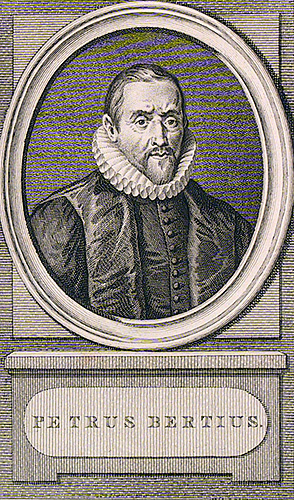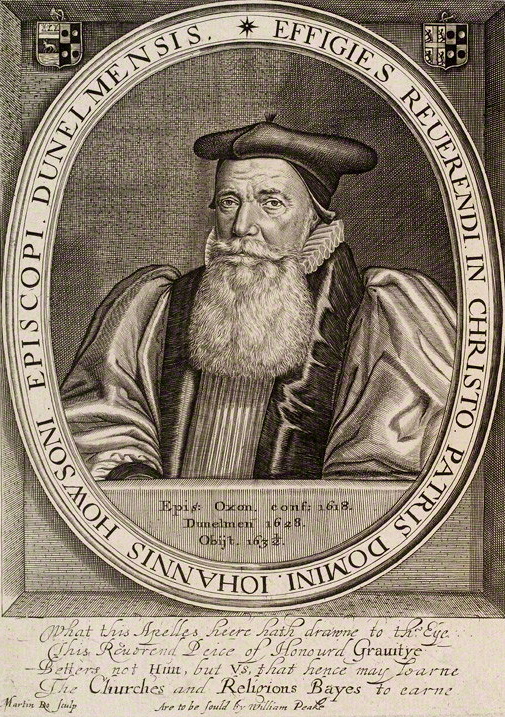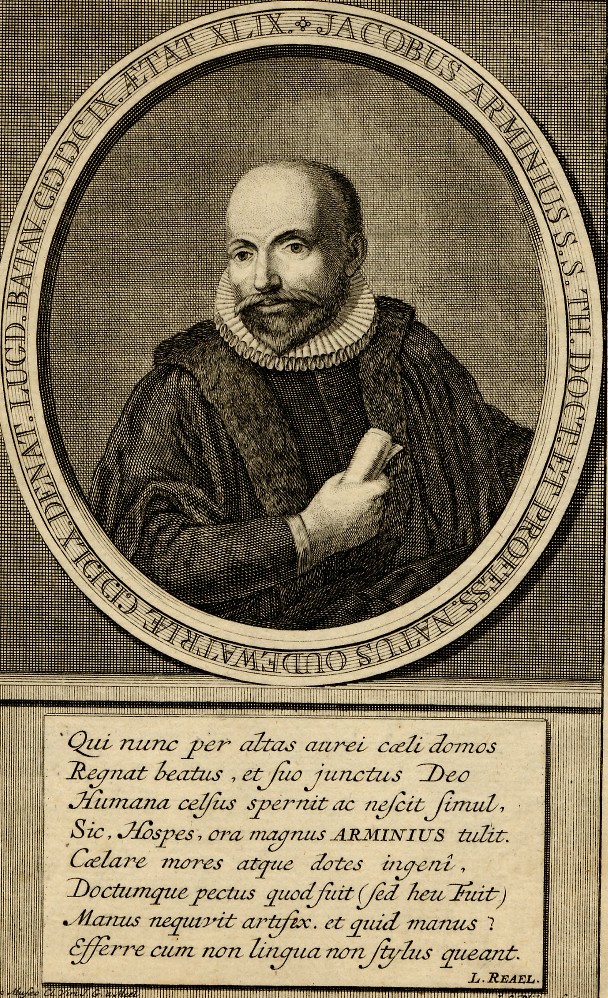|
Robert Abbot (bishop)
Robert Abbot (1560 – 2 March 1618) was an Anglican bishop, academic and polemical writer. He served as Master of Balliol College, Oxford, Regius Professor of Divinity, and Bishop of Salisbury from 1615. Among his four younger brothers, George became Archbishop of Canterbury and Maurice became Lord Mayor of London. Life He was born in Guildford, the elder brother of George Abbot the future archbishop. Both brothers were educated at the Royal Grammar School, Guildford, and Balliol College, Oxford. He early distinguished himself as a preacher, and a sermon which he preached at Paul's Cross gained for him the living of Bingham, Nottinghamshire, to which he was presented by John Stanhope. King James appointed Abbot one of the chaplains in ordinary. In 1609, he was elected master of Balliol College. In 1613 he became Regius Professor of Divinity at Oxford and attacked the writings of Petrus Bertius, a Dutch Remonstrant, on the topic of falling from grace. Subsequently, he made a ... [...More Info...] [...Related Items...] OR: [Wikipedia] [Google] [Baidu] |
Petrus Bertius
Petrus Bertius (also Peter Bertius; Pieter de Bert) (14 November 1565 – 13 October 1629) was a Flemish philosopher, theologian, historian, geographer and cartographer. Bertius published much in mathematics, and historical and theological works, but he is now best known as cartographer with his edition of the ''Geographia'' of Ptolemy (based on Mercator's edition from 1578), and for its atlas. Early life He was born in Beveren (Alveringem), the son of a Flemish preacher Pieter Michielszoon Bardt, who left Flanders for religious exile in London around 1568, with his family. In 1577 Petrus Bertius returned to the Netherlands, to study at the University of Leiden. He supported himself by tutoring younger students and continued travelling in Europe. In 1593 he was appointed to subregent of the Leiden ''Statencollege'', marrying in the same year Maritgen, daughter of Johannes Kuchlinus, the first regent of the ''Statencollege'', whom he would succeed after his death in 1606 as a re ... [...More Info...] [...Related Items...] OR: [Wikipedia] [Google] [Baidu] |
Latin Language
Latin (, or , ) is a classical language belonging to the Italic languages, Italic branch of the Indo-European languages. Latin was originally a dialect spoken in the lower Tiber area (then known as Latium) around present-day Rome, but through the power of the Roman Republic it became the dominant language in the Italy (geographical region), Italian region and subsequently throughout the Roman Empire. Even after the Fall of the Western Roman Empire, fall of Western Rome, Latin remained the common language of international communication, science, scholarship and academia in Europe until well into the 18th century, when other regional vernaculars (including its own descendants, the Romance languages) supplanted it in common academic and political usage, and it eventually became a dead language in the modern linguistic definition. Latin is a fusional language, highly inflected language, with three distinct grammatical gender, genders (masculine, feminine, and neuter), six or seven ... [...More Info...] [...Related Items...] OR: [Wikipedia] [Google] [Baidu] |
Consecration
Consecration is the solemn dedication to a special purpose or service. The word ''consecration'' literally means "association with the sacred". Persons, places, or things can be consecrated, and the term is used in various ways by different groups. The origin of the word comes from the Latin stem ''consecrat'', which means dedicated, devoted, and sacred. A synonym for consecration is sanctification; its antonym is desecration. Buddhism Images of the Buddha and bodhisattvas are ceremonially consecrated in a broad range of Buddhist rituals that vary depending on the Buddhist traditions. Buddhābhiseka is a Pali and Sanskrit term referring to these consecration rituals. Christianity In Christianity, consecration means "setting apart" a person, as well as a building or object, for God. Among some Christian denominations there is a complementary service of "deconsecration", to remove a consecrated place of its sacred character in preparation for either demolition or sale for s ... [...More Info...] [...Related Items...] OR: [Wikipedia] [Google] [Baidu] |
Bishop Of Lincoln
The Bishop of Lincoln is the ordinary (diocesan bishop) of the Church of England Diocese of Lincoln in the Province of Canterbury. The present diocese covers the county of Lincolnshire and the unitary authority areas of North Lincolnshire and North East Lincolnshire. The bishop's seat ('' cathedra'') is located in the Cathedral Church of the Blessed Virgin Mary in the city of Lincoln. The cathedral was originally a minster church founded around 653 and refounded as a cathedral in 1072. Until the 1530s the bishops were in full communion with the Roman Catholic Church. The historic medieval Bishop's Palace lies immediately to the south of the cathedral in Palace Yard; managed by English Heritage, it is open to visitors. A later residence (first used by Bishop Edward King in 1885) on the same site was converted from office accommodation to reopen in 2009 as a 16-bedroom conference centre and wedding venue. It is now known as Edward King House and provides offices for the bishop ... [...More Info...] [...Related Items...] OR: [Wikipedia] [Google] [Baidu] |
Richard Neile
Richard Neile (or Neale; 1562 – 31 October 1640) was an English churchman, bishop successively of six English dioceses, more than any other man, including the Archdiocese of York from 1631 until his death. He was involved in the last burning at the stake for heresy in England, that of the Arian Edward Wightman in 1612. Early life Neile was born in Westminster, and baptised on 11 March 1562 at St Margaret's, Westminster. He was son of a tallow-chandler, though his grandfather had been a courtier and official under Henry VIII, until he was deprived for non-compliance with the Six Articles. He was educated at Westminster School, under Edward Grant and William Camden. He was sent by Mildred, Lady Burghley (wife of Lord Burghley), on the recommendation of Gabriel Goodman to St John's College, Cambridge as a poor scholar, matriculating at Easter 1580, graduating B.A. 1584, M.A. 1587, B.D. 1595, D.D. 1600. Ordained deacon and priest at Peterborough in 1589, he continued to ... [...More Info...] [...Related Items...] OR: [Wikipedia] [Google] [Baidu] |
Protestant Reformation
The Reformation (alternatively named the Protestant Reformation or the European Reformation) was a major movement within Western Christianity in 16th-century Europe that posed a religious and political challenge to the Catholic Church and in particular to papal authority, arising from what were perceived to be errors, abuses, and discrepancies by the Catholic Church. The Reformation was the start of Protestantism and the split of the Western Church into Protestantism and what is now the Roman Catholic Church. It is also considered to be one of the events that signified the end of the Middle Ages and the beginning of the early modern period in Europe.Davies ''Europe'' pp. 291–293 Prior to Martin Luther, there were many earlier reform movements. Although the Reformation is usually considered to have started with the publication of the '' Ninety-five Theses'' by Martin Luther in 1517, he was not excommunicated by Pope Leo X until January 1521. The Diet of Worms of May 1521 ... [...More Info...] [...Related Items...] OR: [Wikipedia] [Google] [Baidu] |
Puritans
The Puritans were English Protestants in the 16th and 17th centuries who sought to purify the Church of England of Roman Catholic practices, maintaining that the Church of England had not been fully reformed and should become more Protestant. Puritanism played a significant role in English history, especially during the Protectorate. Puritans were dissatisfied with the limited extent of the English Reformation and with the Church of England's toleration of certain practices associated with the Roman Catholic Church. They formed and identified with various religious groups advocating greater purity of worship and doctrine, as well as personal and corporate piety. Puritans adopted a Reformed theology, and in that sense they were Calvinists (as were many of their earlier opponents). In church polity, some advocated separation from all other established Christian denominations in favour of autonomous gathered churches. These Separatist and Independent strands of Puritanism became ... [...More Info...] [...Related Items...] OR: [Wikipedia] [Google] [Baidu] |
William Laud
William Laud (; 7 October 1573 – 10 January 1645) was a bishop in the Church of England. Appointed Archbishop of Canterbury by Charles I in 1633, Laud was a key advocate of Charles I's religious reforms, he was arrested by Parliament in 1640 and executed towards the end of the First English Civil War in January 1645. A firm believer in episcopalianism, or rule by bishops, "Laudianism" refers to liturgical practices designed to enforce uniformity within the Church of England, as outlined by Charles. Often highly ritualistic, these were precursors to what are now known as high church views. In theology, Laud was accused of Arminianism, favouring doctrines of the historic church prior to the Reformation and defending the continuity of the English Church with the primitive and medieval church, and opposing Calvinism. On all three grounds, he was regarded by Puritan clerics and laymen as a formidable and dangerous opponent. His use of the Star Chamber to persecute opponents su ... [...More Info...] [...Related Items...] OR: [Wikipedia] [Google] [Baidu] |
John Howson
John Howson ( – 6 February 1632) was an English academic and bishop. Life He was born in the London parish of St Bride's Church, and educated at St Paul's School (London), St Paul's School. He was a student and then a canon of Christ Church, Oxford, and Vice-Chancellor of the University of Oxford, Vice-Chancellor in 1602. James I of England appointed him to Chelsea College (17th century), Chelsea College. He became rector of Brightwell Baldwin in 1608. Conflicts in Oxford with Calvinist clergy led to his being accused in 1615 before the King of popery, by George Abbot (bishop), George Abbot, Archbishop of Canterbury. He was able to convince the King that the charges were misplaced, and began to rise in the hierarchy, where he was an influence on the Arminian side. He was Bishop of Oxford from 1619, and Bishop of Durham from his translation there in September 1628. He was buried in Old St Paul's Cathedral in London, but the grave and monument were destroyed in the Great Fi ... [...More Info...] [...Related Items...] OR: [Wikipedia] [Google] [Baidu] |
Jacobus Arminius
Jacobus Arminius (10 October 1560 – 19 October 1609), the Latinized name of Jakob Hermanszoon, was a Dutch theologian during the Protestant Reformation period whose views became the basis of Arminianism and the Dutch Remonstrant movement. He served from 1603 as professor in theology at the University of Leiden and wrote many books and treatises on theology. Following his death, his challenge to the Reformed standard, the ''Belgic Confession'', provoked ample discussion at the Synod of Dort, which crafted the five points of Calvinism in response to Arminius's teaching. Early life Arminius, was born in 1559 or 1560 in Oudewater, Utrecht. He became an orphan while still young. His father Herman, a manufacturer of weapons, died, leaving his wife a widow with small children. He never knew his father, and his mother was killed during the Spanish massacre at Oudewater in 1575. The child was adopted by Theodorus Aemilius, a priest inclined towards Protestantism. Around 1572 (th ... [...More Info...] [...Related Items...] OR: [Wikipedia] [Google] [Baidu] |
Augustine Of Hippo
Augustine of Hippo ( , ; la, Aurelius Augustinus Hipponensis; 13 November 354 – 28 August 430), also known as Saint Augustine, was a theologian and philosopher of Berber origin and the bishop of Hippo Regius in Numidia, Roman North Africa. His writings influenced the development of Western philosophy and Western Christianity, and he is viewed as one of the most important Church Fathers of the Latin Church in the Patristic Period. His many important works include ''The City of God'', '' On Christian Doctrine'', and '' Confessions''. According to his contemporary, Jerome, Augustine "established anew the ancient Faith". In his youth he was drawn to the eclectic Manichaean faith, and later to the Hellenistic philosophy of Neoplatonism. After his conversion to Christianity and baptism in 386, Augustine developed his own approach to philosophy and theology, accommodating a variety of methods and perspectives. Believing the grace of Christ was indispensable to human freed ... [...More Info...] [...Related Items...] OR: [Wikipedia] [Google] [Baidu] |





.jpg)



